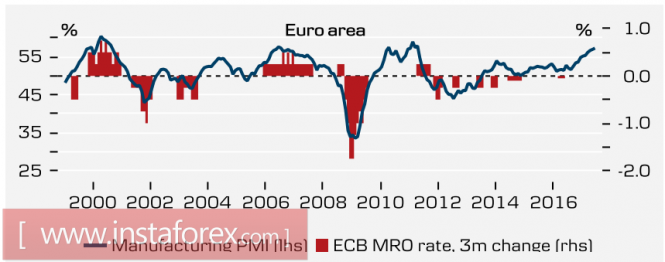Eurozone
The coming week may bring a revision of the euro's prospects and the market as a whole due to the fact that the European currency will get an additional opportunity to continue growth. In one of his recent speeches, ECB President Mario Draghi said that in order to understand the dynamics of inflation, it is necessary to look at the process from two sides - the impact of monetary policy on aggregate demand and on the other side, the impact of the demand for inflation.
According to the first factor, the situation is clear - the rapid growth of the euro area PMI indicates the tightening monetary policy lags behind the growth of the economy. Therefore, the markets as a whole are guided by the fact that the ECB will, willy-nilly, be forced to take steps in favor of tightening which is a factor for the euro to grow.

On the second issue, there are different estimates. The labor market in the euro area, despite some improvement, is still weak. This gives the ECB the right to take a break and not announce the imminent completion of the asset repurchase program at the upcoming meeting in Thursday, July 20. It should be noted here that central banks appear to be governed by the rule of Philips, an English economist who showed that unemployment rate depends on the growth of the average wage and, as a consequence, the growth of inflation. A number of central banks have already begun to tighten the policy based on the growth of the economy which should also contribute to inflation. Investors proceed from the fact that the statement of the ECB following the meeting will somehow contain items on the discussion on the issue of reducing incentives.
These expectations will support the euro.
On Monday, the report on inflation in the eurozone for June will be published. Expectations are neutral with a bias towards the probability of a price increase compared to May. On Tuesday, the ZEW economic sentiment for Germany and the euro area was published. It is expected that they will confirm the growth of activity and will also contribute to the growth of demand for euro.
In general, the European currency has no reason to decline. Internal factors contribute to the growth of the euro. External factors are primarily data from the US which look unfavorable for the dollar. The appearance of a driver for its growth in the short term is unlikely. The euro can rise by the end of the week to 1.1650.
United Kingdom
The pound finished the week with strong growth facilitated by the joint effect of several factors at once, The first of these is the weak data on consumer inflation in the US for the month of June which contributed to the decrease in expectations in the growth rate of the Fed. Meanwhile, there is an increase in the probability that the Bank of England will tighten monetary policy.
The second factor is somehow connected with the Brexit. The markets have positively accepted the desire of the British authorities to find a compromise with the EU. On Thursday, the British government sent a statement to the parliament noting the existence of mutual commitments between the EU and the UK. Therefore, there is a need to work together to find a fair settlement of disputes. This statement shows that the probability of a "soft" exit is growing, which in turn, reduces risks for investors.
Tuesday is a key day for the pound. A report on producer prices and consumer inflation in June will be published which will allow to adjust the expectations for the rate. While the markets are set to the fact that the data will not be worse than the May data and will show an increase in price pressure, and if these expectations are justified, the pound will be able to continue its growth. Data output that is worse than expectations can trigger a correction as the pound has updated to a 10-month high and the need to break increases.
Oil and Ruble
The phase of the rapid strengthening of the ruble has apparently ended. At the current stage, the inflow of foreign capital has become noticeably weaker, investors are trying to fix profit on the background of uncertain prospects for the dynamics of oil prices and the future of the economy.
On Friday, the Central Bank approved the inflation forecast of 4.3%. This estimate coincides with the forecast of the Ministry of Economic Development. The growth of inflation in May, according to the Central Bank, will not prevent the achievement of the previously announced goal that will be reached by the end of the year. Therefore, the potential for further rate cuts remain. The ruble will trade in the sideways range at around 60 rubles per dollar before a new driver appears.
The material has been provided by InstaForex Company - www.instaforex.com